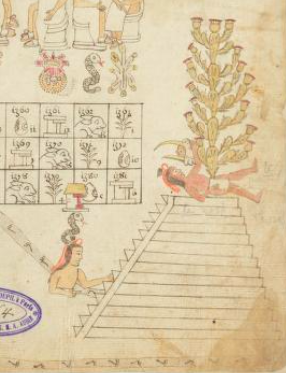nopalli (Azca18)
This painted black-line drawing of an iconographic example of a nopalli (prickly pear cactus, spelled nohpalli with the glottal stop) seems to be growing out of the body of a reclining man. His skin tone is painted pink. He wears a loincloth, and he has his hair tied–perhaps with an orange thon–into what looks like a tzontli (a bundle of hair sticking straight up above the head). His feet are apart, as though in motion. His left arm is also raised up near what appears to be a hummingbird head (perhaps Huitzilopochtli?) with a small human face peeking out from inside the beak. The cactus has a trunk with five segments, each one with a double branch (penca) structure with a flower-turning-fruit (nochtli) at the end of each one, comprising fifteen nochtli in all.
Stephanie Wood
This nopal cactus coming up from a human body is reminiscent of the genealogical tree that is a prickly pear cactus, found in the García Granados Codex. An image is published in Mexicolore. Many features of this Azcatitlan Codex seem either late or unorthodox when compared to glyphs from manuscripts known for certain to be from the sixteenth century.
Stephanie Wood
Stephanie Wood
post-1550, possibly from the early seventeenth century.
Jeff Haskett-Wood
cactos, nopales, prickly pears
nopal(li), prickly pear cactus, https://nahuatl.wired-humanities.org/content/nopalli
nopal
Stephanie Wood
The Codex Azcatitlan is also known as the Histoire mexicaine, [Manuscrit] Mexicain 59–64. It is housed in the Bibliothèque Nationale de France, and hosted on line by the World Digital Library and the Library of Congress, which is “unaware of any copyright or other restrictions in the World Digital Library Collection.”
https://www.loc.gov/resource/gdcwdl.wdl_15280/?sp=18&st=image
The Library of Congress is “unaware of any copyright or other restrictions in the World Digital Library Collection.” But please cite Bibliothèque Nationale de France and this Visual Lexicon of Aztec Hieroglyphs.





